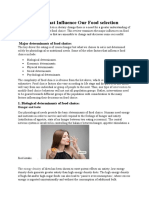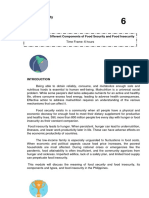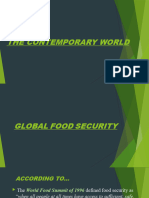Reflective Task
Uploaded by
rishabhvasisht03Reflective Task
Uploaded by
rishabhvasisht03Individual, Social and Environmental Perspective on Food Consumption: Reflective Task
Words: 1593
Section 1: Learning about Socioeconomic and Individual Impact on Food Choices
Food is essential for our survival and to satisfy our physiological needs. While hunger is the biological drive
for food consumption, multiple social factors influence on how this basic human need is meet. Cultural,
religious, economic and political social factors affect the accessibility and consumption of food (figure 1).
“Food in the Anthropocene represents one of the greatest health and environmental challenges of the 21st
century” – EAT Lancet Commission on unhealthy diets, Lancet, 2019. Furthermore, national health
guidelines exist to ensure that the population is aware of the quality and quantity of food that should be
consumed for a healthy lifestyle.
Figure 1: Socioeconomic determinants for
food consumption
Beginning of life mostly everyone consumes
the same milk diet, however, due to our
socioeconomic differences especially culture,
food habits vary drastically. This is
represented by the existence of national
cuisines which display the broad range of
diets. Habitual consumption of certain foods is
heavily dictated by cultural influence. Foods
prepared traditionally or for an event can lead
to restrictions or exclusion of meats and milk
from diet (The Factors That Influence Our
Food Choices: (EUFIC), n.d.). An example of
such exclusion is, Hindus do not consume
beef, as cows are considered sacred in our
religion. This leads to limited choices as beef
Figure 2: Total burden of disease by socioeconomic is one of the most produced meats. Social
class influence is also prominent in food
area, 2018
consumption and nutrient intake. Population
studies have shown a clear difference in social classes. Lower social classes usually result in individuals with
micronutrient deficiency leading to diseases, while higher social classes are able to maintain or even surpass
the daily calorie intake (Germov & Williams, 1999). This is represented in figure 2 which displays the
DALY (one healthy year of life lost) against the different socioeconomic area (1 being the lowest and 5
being the highest).
Due to their lower cost, processed foods, fast food, and sugary drinks are frequently consumed in low-
income homes. These foods are typically less nutrient-dense and higher in fat, sugar, and salt. Moreover,
they eat fewer fruits and vegetables due to its high cost. Contrarily, households with higher incomes have
access to a wider variety of nutrient-dense foods such fruits, vegetables, whole grains, lean proteins, as well
as organic and regionally grown goods. Due to a lack of resources, food insecurity is common in low-income
homes, which has an adverse effect on eating habits and may cause people to skip meals or buy inexpensive,
Individual, Social and Environmental Perspective on Food Consumption: Reflective Task
Words: 1593
low-quality food (Germov & Williams, 2017). Therefore, the economic background of the individual
majorly impacts the perception and consumption of food. Lack of recreational sporting sites to the low-
income households and areas limits the exercise of the individual. This further ignites the problem of poor
nutrition by accompanying it with poor exercise outlets.
Education and nutrition knowledge can influence dietary behaviour; however, good nutrition knowledge is
not strongly correlated with good dietary habits. Knowledge about health does not lead to direct action when
individual is either unsure how to apply the knowledge, lacks the correct outlet to perform the right
procedures or lacks the motivation to act upon the knowledge. Hence, individual determinants are also key in
describing the dietary behaviour of a person. Food consumption is influenced by a person's tastes, attitudes,
beliefs, knowledge, and behaviours. People tend to choose foods they like and stay away from the foods they
detest; therefore, personal taste is a key factor (The Factors That Influence Our Food Choices: (EUFIC),
n.d.). Food preferences can also be influenced by attitudes, cultural or religious beliefs, and nutrition
knowledge. Those who eat larger portions or unhealthy snacks between meals may consume more calories
than they need to, thus behaviours like portion management, snacking patterns, and meal frequency can all
have an impact on how much food is consumed. These determinants are complicated and can change
depending on several variables.
Health guidelines exist nationally to educate the population about the required nutrition needed to live a
healthy life (table 1) (Australian Government, 2022). Although the guidelines are available to the general
public, due to the lack of education, cultural and religious food practices or a lack of motivation, are unable
to uphold these normative standards (figure 3).
Therefore, despite humans sharing similar physiological needs, food habits and diets are not natural, global
or inevitable, but rather are social constructions.
Table 1: Australian Institute of Health and Welfare Normative Standards, 2022
Figure 3: Contribution of poor diet to chronic diseases, (Australian Institute of
Health and Welfare, 2022)
Individual, Social and Environmental Perspective on Food Consumption: Reflective Task
Words: 1593
Section 2: Understanding and Reflecting on Personal Food Choices
Through my learning, I have gained valuable insights into my own food practices, attitudes and beliefs. The
biggest determinants of my food choices are my cultural and religious beliefs and my individual taste
preferences. Through analysing the lectures and tutorial content, I realised how fortunate I am to be
economically secure, possess basic nutritional knowledge and have environmental accessories to help with
maintaining a healthy life. I have also gained a new perspective onto my food consumption.
Personally, the biggest determinant to my food choices have been cultural and religious beliefs. I have been
brought up in a Hindu and Indian household which has cultivated many food practices into me since
childhood. I have been practicing these food choices for years without conscious effort as they were second
nature. However, after analysing and understanding the content presented in this topic, I have gained a new
perspective onto my food consumption. Southeast Asians tend to consume foods containing high fat and oil
content as a part of our cultural diet (Nutrition in the South-East Asia Region, n.d.). This has led to our
population on average having high blood pressure, obesity/ overweight individuals and high cholesterol
levels. Personally, I consume high contents of oily and fat saturated foods that are culturally driven such as
pakora and samosa (north Indian meals). Hence, I have developed a taste for high calorie and high fat foods
which has led me to be in risk of multiple health diseases. I have personally suffered from obesity in the past
and was consulted with a nutritionist due to my consumption of high calorie foods. I am also brought up in a
Hindu Brahmin household which resulted in my not being allowed to consume any non-vegetarian food until
I was 18 years old. This significantly impacted my ability to eat lean meat which is significant contributor of
nutrients. The content covered in this topic has aided me in realising how much culture and religious beliefs
have impacted my nutrition and dietary habits. I have been limited to a small selection of food that mostly
consisted of high fat and oil dietary options.
Although I was overweight and was consuming high fat content foods, due to the excessive amount of food I
was eating I was able to receive the required nutrients my body needed to grow. This perfectly represents
high-economic status individuals which consume high calorie content food however also are able to receive
nutrients along with the food. Furthermore, in Indian households the food is usually homemade, which is a
hassle to create a full meal each time. Hence, usually the food is made in excess so it can be used later. This
has been a major cultural determinant as this usually leads to overconsumption.
My perception on food has changed due to the content discussed in this topic drastically. I am able to view
my daily dietary habits and realise how much fatty and oily foods I consume. I have developed a better
understanding of my cultural impact on food and hence my food preferences have shifted to carter more
towards healthier alternatives. My taste preference is still directed more towards my original preferences
however, my outlook on those foods is overall negative.
Section 3: Applying Understanding of Food Consumption
I have developed a taste of high calorie and fatty foods due to my cultural beliefs. Through the course of this
topic, I have gained the capability to discern between healthy food habits and how they can be impacted by a
variety of factors outside our control. As I mentioned earlier my perceptive of food has shifted to try and
consume healthier alternatives to my cultural diet. I have realised that my taste preference and cultural and
religious beliefs have influenced my diet negatively. My perception of my food practices has led me to
pursue a healthier lifestyle by also analysing the labelling of the food I eat to fully understand the nutrition
value the food is offering. I was blind sighted to my food practices as they were second nature, however, I
am starting to question a few of the dishes prepared at home to raise awareness in my household about
finding better alternatives. I am also starting to educate my family and fellow Indian friends regarding the
dangers of cultural diet habits to ensure a safe and healthy life.
Individual, Social and Environmental Perspective on Food Consumption: Reflective Task
Words: 1593
My perception about other people’s food practices has changed drastically as well. I used to relate being
overweight/ obese with bad choices made by the individual. However, I will strive to be more accepting and
non-judgmental, understanding that people's dietary preferences are influenced by a variety of external
variables. Lack of education, lack of food access due to financial trouble can be major contributors to poor
health. These factors are based on the society and environmental determinants. Hence, my false prejudice has
changed, and I will try to understand the socioeconomic background of the individual before forming any
perception.
Working as a health professional, I would put what I've learned to practice by approaching health
holistically. I would try to comprehend the societal and personal factors that influence my patients' dietary
decisions and collaborate with them to come up with practical and long-lasting solutions to enhance their
general health. Considering that everyone has a right to healthy and nutritious food, I would also support
laws and programmes that encourage food access and affordability for all. Spreading awareness about food
and nutrition to the public especially to low-income households would increase the quality of life
dramatically.
References:
The Factors That Influence Our Food Choices: (EUFIC). (n.d.). Www.eufic.org.
https://www.eufic.org/en/healthy-living/article/the-determinants-of-food-choice#:~:text=Social
%20determinants%20such%20as%20culture
Germov, J., & Williams, L. (1999). A Sociology of Food and Nutrition. Oxford University Press, USA.
Germov, J., & Williams, L. (2017). A sociology of food & nutrition: the social appetite. Oxford University
Press.
Australian Government. (2013). EAT FOR HEALTH Australian Dietary Guidelines summary 2013.
https://www.eatforhealth.gov.au/sites/default/files/files/the_guidelines/
n55a_australian_dietary_guidelines_summary_book.pdf
Australian Institute of Health and Welfare. (2022, July 23). Australia’s health 2022. Australian Institute of
Health and Welfare. https://www.aihw.gov.au/reports-data/australias-health
Nutrition in the South-East Asia Region. (n.d.). Www.who.int. https://www.who.int/southeastasia/health-
topics/nutrition
You might also like
- Vestige Prime Concentrated Mineral Drops Launch Presentation100% (2)Vestige Prime Concentrated Mineral Drops Launch Presentation32 pages
- Fst 201 Dr Akintundes Section 2022 Edited Food HabitsNo ratings yetFst 201 Dr Akintundes Section 2022 Edited Food Habits9 pages
- The Determinants Food Choice EUFIC REVIEW 2004No ratings yetThe Determinants Food Choice EUFIC REVIEW 20046 pages
- The Factors That Influence Our Food Choices: 1. Major Determinants of Food ChoiceNo ratings yetThe Factors That Influence Our Food Choices: 1. Major Determinants of Food Choice18 pages
- A Healthy Diet Sustainably Produced: November 2018 Information SheetNo ratings yetA Healthy Diet Sustainably Produced: November 2018 Information Sheet8 pages
- Reading Passage Comprehension and Responding To CRQsNo ratings yetReading Passage Comprehension and Responding To CRQs6 pages
- The Power of Food - How What We Eat Shapes Our LivesNo ratings yetThe Power of Food - How What We Eat Shapes Our Lives2 pages
- Food and Nutrition Issues and Challanges of CommonNo ratings yetFood and Nutrition Issues and Challanges of Common24 pages
- Culture Should Be Considered When Making Radical Dietary ChangesNo ratings yetCulture Should Be Considered When Making Radical Dietary Changes3 pages
- Lec 6 Cultural and Religious Influences On Food and NutritionNo ratings yetLec 6 Cultural and Religious Influences On Food and Nutrition4 pages
- Food-taboo-and-dietary-habits-among-lowincome-people-in-Kedah-Malaysia_2023_HACCP-ConsultingNo ratings yetFood-taboo-and-dietary-habits-among-lowincome-people-in-Kedah-Malaysia_2023_HACCP-Consulting14 pages
- The Influence of Time on Food: Nutrition, Age, Life, and Time DifferencesFrom EverandThe Influence of Time on Food: Nutrition, Age, Life, and Time DifferencesNo ratings yet
- The Problem and Its Scope: Encyclopedia of Food Sciences and Nutrition (Second EditionNo ratings yetThe Problem and Its Scope: Encyclopedia of Food Sciences and Nutrition (Second Edition39 pages
- Wepik Exploring Global Food Habits Cultural Influences and Trends 20241114045028vgeyNo ratings yetWepik Exploring Global Food Habits Cultural Influences and Trends 20241114045028vgey8 pages
- Social and Preventive Pharmacy Imp Question and AnswersNo ratings yetSocial and Preventive Pharmacy Imp Question and Answers8 pages
- Orem's Theory of Self-Care and Kolcaba's Theory of Comfort - Essay ExampleNo ratings yetOrem's Theory of Self-Care and Kolcaba's Theory of Comfort - Essay Example7 pages
- Omnibus Health Guidelines For Adults Version 2023100% (1)Omnibus Health Guidelines For Adults Version 2023216 pages
- ACE Sports Nutrition For Health Professionals PagesNo ratings yetACE Sports Nutrition For Health Professionals Pages4 pages
- Theoretical Basis of Professional Nursing. BOPN317 Dorothea Orem'S Theory of NursingNo ratings yetTheoretical Basis of Professional Nursing. BOPN317 Dorothea Orem'S Theory of Nursing45 pages
- Eric Bergstrom Upper Body Workout Plan 3No ratings yetEric Bergstrom Upper Body Workout Plan 32 pages
- Vestige Prime Concentrated Mineral Drops Launch PresentationVestige Prime Concentrated Mineral Drops Launch Presentation
- Fst 201 Dr Akintundes Section 2022 Edited Food HabitsFst 201 Dr Akintundes Section 2022 Edited Food Habits
- The Factors That Influence Our Food Choices: 1. Major Determinants of Food ChoiceThe Factors That Influence Our Food Choices: 1. Major Determinants of Food Choice
- A Healthy Diet Sustainably Produced: November 2018 Information SheetA Healthy Diet Sustainably Produced: November 2018 Information Sheet
- Reading Passage Comprehension and Responding To CRQsReading Passage Comprehension and Responding To CRQs
- The Power of Food - How What We Eat Shapes Our LivesThe Power of Food - How What We Eat Shapes Our Lives
- Food and Nutrition Issues and Challanges of CommonFood and Nutrition Issues and Challanges of Common
- Culture Should Be Considered When Making Radical Dietary ChangesCulture Should Be Considered When Making Radical Dietary Changes
- Lec 6 Cultural and Religious Influences On Food and NutritionLec 6 Cultural and Religious Influences On Food and Nutrition
- Food-taboo-and-dietary-habits-among-lowincome-people-in-Kedah-Malaysia_2023_HACCP-ConsultingFood-taboo-and-dietary-habits-among-lowincome-people-in-Kedah-Malaysia_2023_HACCP-Consulting
- The Influence of Time on Food: Nutrition, Age, Life, and Time DifferencesFrom EverandThe Influence of Time on Food: Nutrition, Age, Life, and Time Differences
- The Problem and Its Scope: Encyclopedia of Food Sciences and Nutrition (Second EditionThe Problem and Its Scope: Encyclopedia of Food Sciences and Nutrition (Second Edition
- Wepik Exploring Global Food Habits Cultural Influences and Trends 20241114045028vgeyWepik Exploring Global Food Habits Cultural Influences and Trends 20241114045028vgey
- Social and Preventive Pharmacy Imp Question and AnswersSocial and Preventive Pharmacy Imp Question and Answers
- Orem's Theory of Self-Care and Kolcaba's Theory of Comfort - Essay ExampleOrem's Theory of Self-Care and Kolcaba's Theory of Comfort - Essay Example
- ACE Sports Nutrition For Health Professionals PagesACE Sports Nutrition For Health Professionals Pages
- Theoretical Basis of Professional Nursing. BOPN317 Dorothea Orem'S Theory of NursingTheoretical Basis of Professional Nursing. BOPN317 Dorothea Orem'S Theory of Nursing

























































































